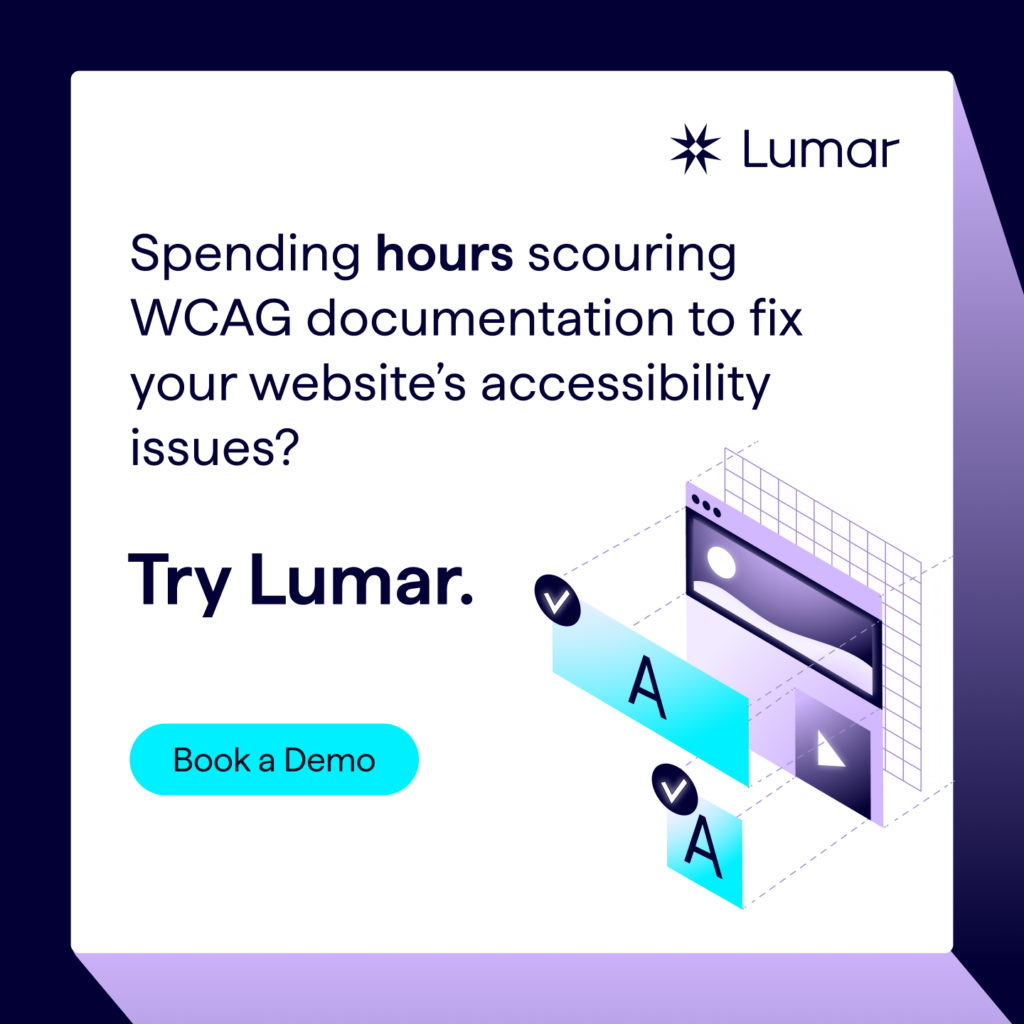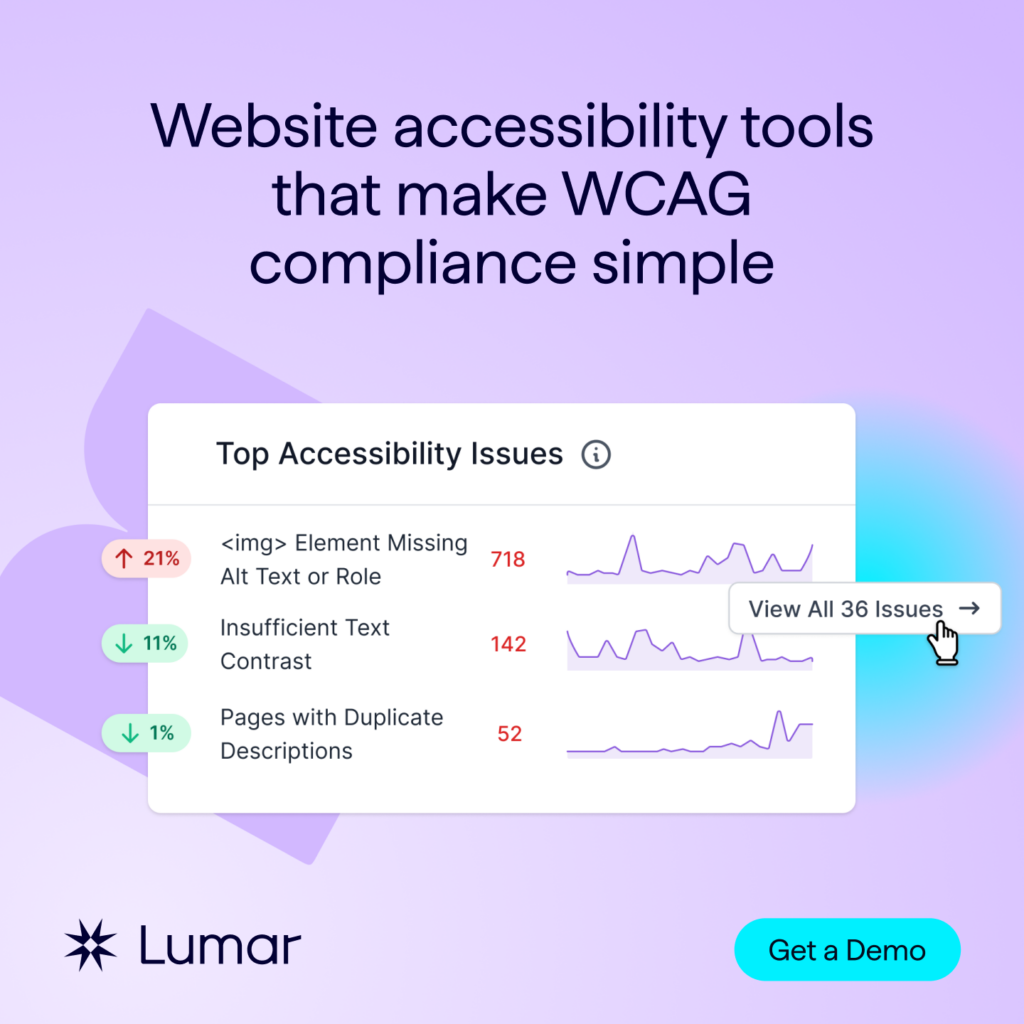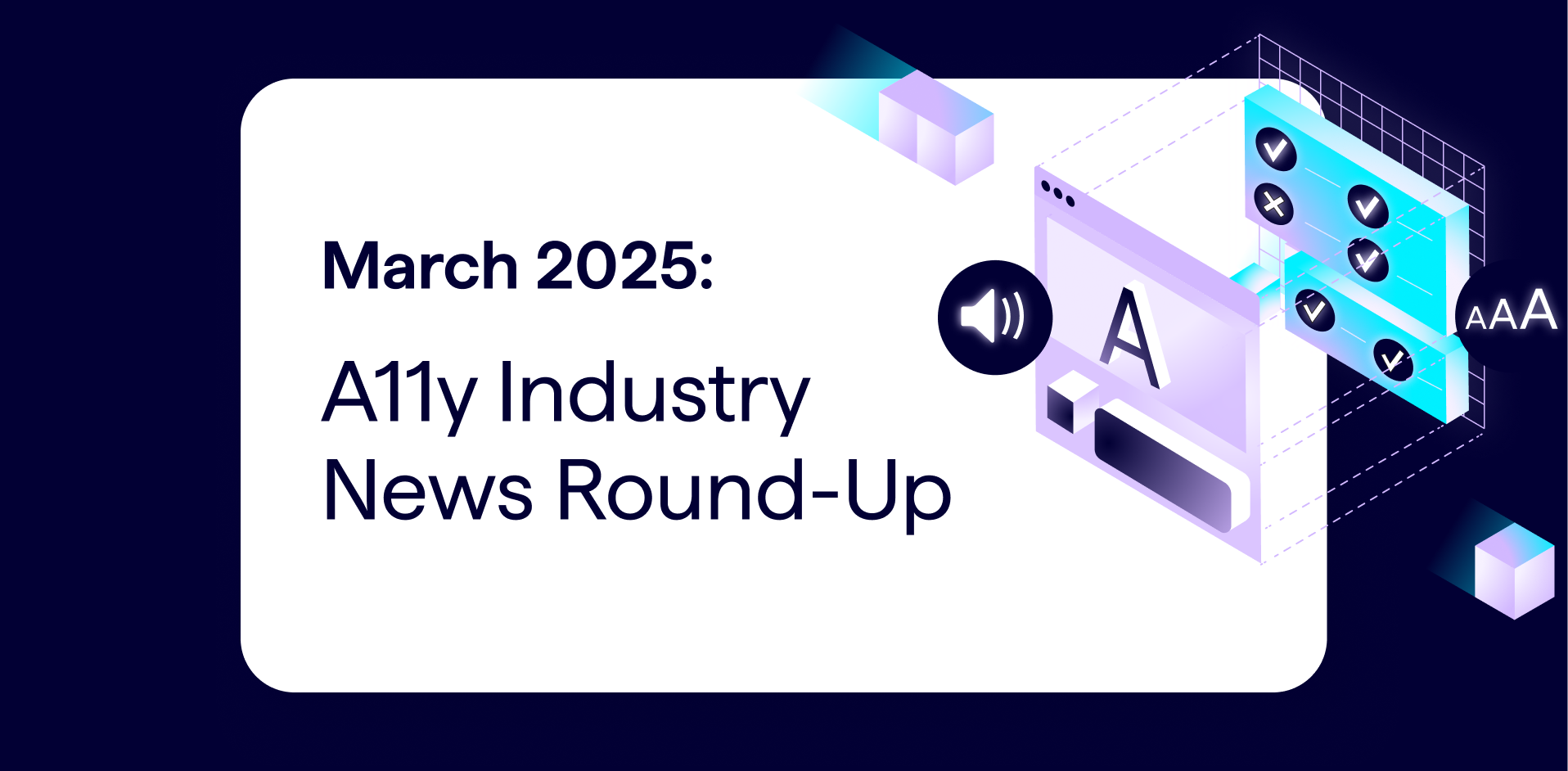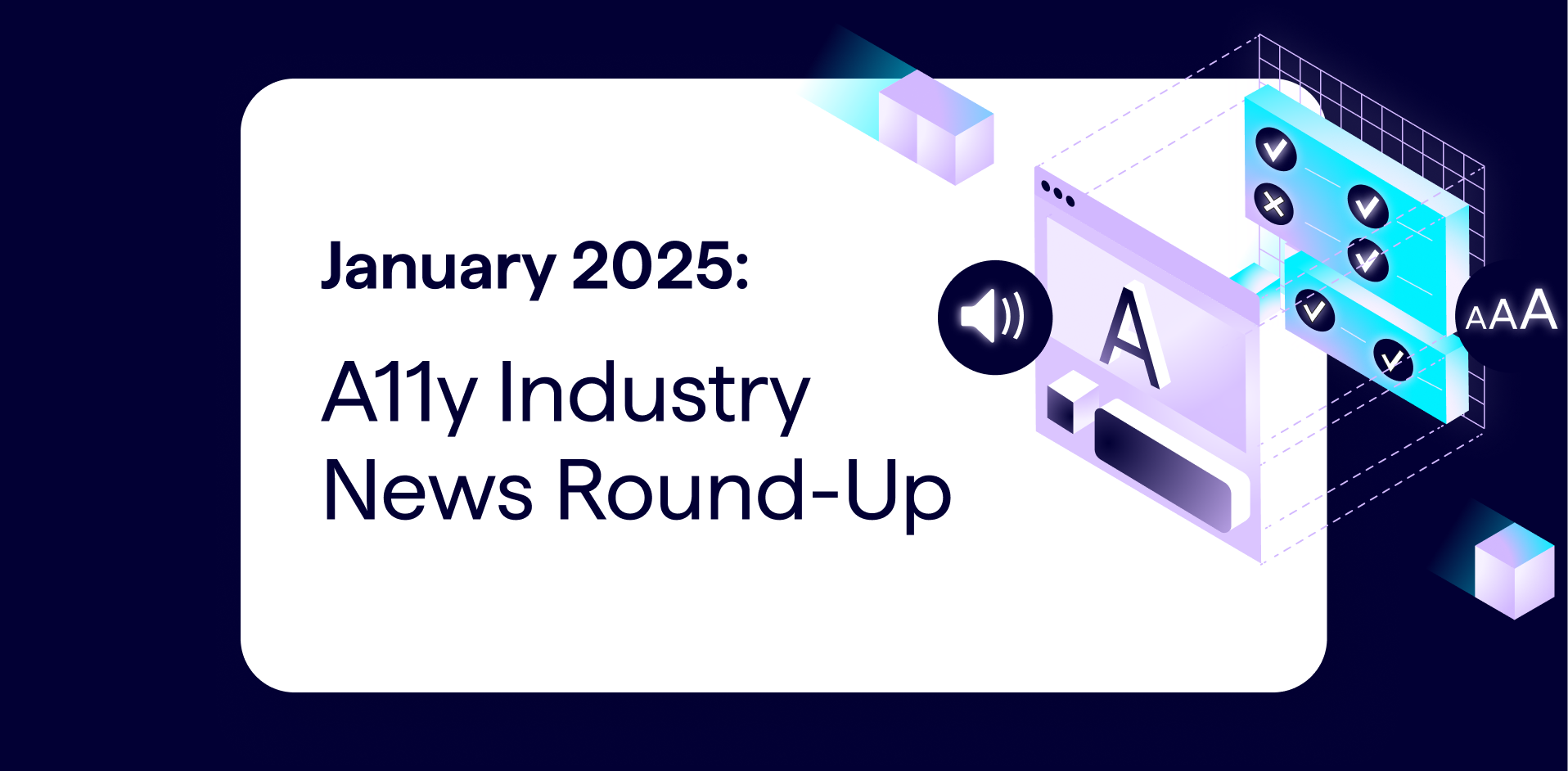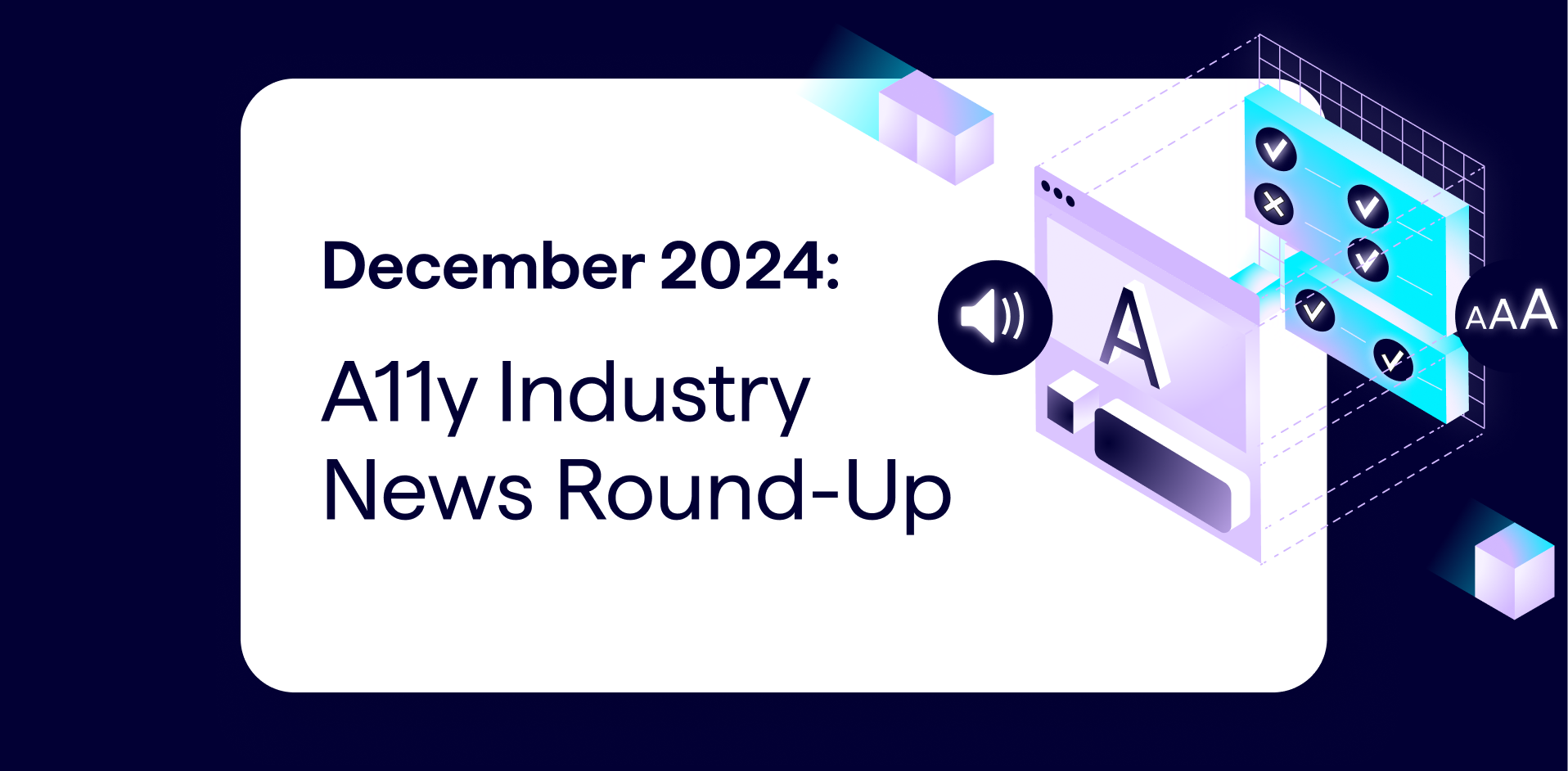What happened in digital accessibility news this month?
Each month, the Lumar team rounds up some of the top digital accessibility headlines for website managers and web accessibility professionals.
For February 2025, our a11y news roundup includes:
- New accessibility technology showcased at CES 2025
- Website accessibility software market expected to grow significantly between 2025 and 2031
- Some accessibility pages have disappeared from US federal websites
- US Department of Justice releases new digital accessibility toolkit to help government agencies comply with ADA rules
- US GSA has released its second annual assessment of federal compliance with Section 508 accessibility rules
- Virginia and New Mexico have proposed bills to bolster digital accessibility at the state level
- UK government publishes report on how they monitor public websites for accessibility
- W3C publishes accessibility requirements for collaboration tools
- … and more!
Read on for the top digital accessibility news stories this month.
Accessibility technology showcased at CES 2025
Numerous accessibility technologies were showcased at the Consumer Electronics Show (CES) 2025 last month, highlighting innovations designed to enhance shared experiences for individuals with disabilities. Among the standout developments on display were AI-enhanced smart glasses capable of providing real-time audio descriptions for visually impaired users and advanced hearing aids that seamlessly integrate with various devices to offer personalized soundscapes.
According to the Forbes article: “Once limited to a niche market, accessibility technology has grown into a global powerhouse. In 2023, the DisabilityTech market was valued at $25 billion, and by 2029, it is expected to reach $37 billion, according to McKinsey Market Research. This surge reflects a growing recognition of the universal benefits of inclusive design.”
Explore some of the featured advancements in accessibility technology on the CES Accessibility page.
(Source: Forbes )
The global website accessibility testing software market is projected to grow at 16.26% CAGR
According to Market Research Intellect, the global Website Accessibility Testing Software market is projected to grow at a strong compound annual growth rate (CAGR) of 16.26% from 2024 to 2031. Starting with a valuation of 6.35 billion in 2024, the market is expected to reach approximately 15.68 billion by 2031, according to the market research firm.
Ongoing updates to digital accessibility legislation around the world — such as the European Accessibility Act (EAA) that will go into effect in June 2025 and recent updates to how the US Americans With Disabilities Act (ADA) applies to websites — is likely contributing to the projected growth in website accessibility software platforms.
(Source: Market Research Intellect Press Release and Market Research Intellect’s “Global Website Accessibility Testing Software Market Size and Forecast”)
Accessibility pages disappearing on US federal websites
Following the US inauguration, several web pages appear to have disappeared from the White House website, including the White House accessibility statement (this page formerly existed at whitehouse.gov/accessibility, which presently returns a ‘404’ page) and the Office of Management and Budget (OMB) directives on digital accessibility — as well as the Consitution page— according to reporting at QualityLogic and elsewhere. Some believe these removals were deliberate and potentially related to new executive orders that aim to dismantle DEI programs, though a White House spokesperson has claimed to USA Today that the removal of certain web pages was instead due to a website redesign and would return soon.
QualityLogic points out that while the new executive orders around DEI programs do not primarily target accessibility, its connection to broader DEIA initiatives places it within the larger conversation. It is worth noting that the Americans with Disabilities Act (ADA) remains enforceable. The QualityLogic team also mentions that US states are increasingly enacting their own digital accessibility laws as well.
(Sources: QualityLogic ; USA Today ; The Hill)
US DOJ unveils new ADA website accessibility toolkit for government agency websites
Last month, the U.S. Department of Justice (DOJ) released a comprehensive a11y toolkit on ADA.gov to assist state and local governments in adhering to a rule mandating enhanced accessibility of their websites for individuals with disabilities.
This initiative clarifies that the Americans with Disabilities Act (ADA) extends to online content, addressing prevalent accessibility issues such as small text sizes, absence of captions for live audio, and complex form instructions that hinder users with disabilities from accessing essential services.
US governments serving populations of 50,000 or more are required to comply by June 2026, while those with smaller populations have until June 2027.
The DOJ acknowledges that compliance costs, encompassing the remediation of existing content and ensuring ongoing adherence, are projected to reach millions of dollars.
(Sources: Route Fifty & ADA, “State and Local Governments: First Steps Toward Complying with the Americans with Disabilities Act Title II Web and Mobile Application Accessibility Rule” )
US GSA has released its second annual assessment of federal compliance with Section 508 accessibility rules
The US General Services Administration (GSA) has released its second annual report on federal compliance with Section 508 of the Rehabilitation Act, including the most recently available 2024 data.
The report indicates slight improvements in the maturity of federal IT and digital accessibility programs, but it also highlights that the federal government continues to fall short of its legal and statutory obligations to ensure equal access of information for individuals with disabilities, including federal employees and members of the public.
The report found that just one-third or less of the most-viewed digital content fully conforms to the accessibility standards set out in Section 508. The percentages of fully conformant federal digital content breaks down as follows:
- 23% of public internet pages
- 20% of intranet pages
- 25% of public documents
- 34% of videos
Approximately half of the reporting entities said they lacked the resources to test their top-viewed content for accessibility compliance. While 70% of respondents said they perform Section 508 conformance testing on their public internet web pages, only 41% of respondents perform Section 508 conformance testing on internal intranet websites as part of their standard practices.
(Source: US GSA Section 508 report )
Virginia and New Mexico have proposed bills to bolster digital accessibility at the state level
Last month, state representatives in both Virginia and New Mexico introduced proposals that would help bolster accessible technology efforts in their respective states.
Virginia has introduced House Bill (HB) 2541, a bill aimed at strengthening the state’s Information Technology Access Act by broadening accessibility requirements beyond just blind and visually impaired residents to include other disabilities. The proposed legislation also seeks to enhance the state’s procurement process by requiring vendors to submit a Voluntary Product Accessibility Template (VPAT) or Accessibility Conformance Report (ACR) from a qualified expert and to provide an Accessibility Roadmap detailing plans and timelines for closing accessibility gaps. Additionally, the bill encourages (but does not mandate) state agencies to appoint a digital accessibility coordinator. While the bill stops short of requiring third-party audits or mandating perfection in accessibility compliance, it prioritizes continuous improvement in IT accessibility.
Meanwhile, in January 2025, New Mexico has proposed a new Accessibility Act that would require state agency websites and mobile apps to comply with WCAG 2.1 A/AA by April 1, 2026, mandate accessibility statements outlining compliance efforts, and establish a new office to educate agencies on digital accessibility while reporting biannually to the governor. The bill also allows private rights of action for injunctive relief against non-compliant agencies. While much of the proposal aligns with the DOJ’s new ADA Title II web accessibility rule, the inclusion of accessibility statements and a dedicated digital accessibility office are unique. Advocates see these additions as positive steps, particularly the creation of a state-level office to provide practical guidance, something the DOJ has yet to fully deliver.
(Sources: Converge Accessibility Legal Updates ; LegiScan, Virginia House Bill 2541 ; LegiScan, New Mexico House Bill 120 ]
The UK government’s accessibility monitoring team has released a report on how British public sector websites are monitored and an audit of the Met Office’s a11y improvements
Last month, The UK’s Government Digital Service published findings from three years of monitoring public sector websites and mobile apps for accessibility compliance. The report highlights common issues and provides guidance for improvement.
The UK’s Accessibility Monitoring team at Government Digital Service (GDS) audits public sector websites and apps to see if they meet accessibility regulations outlined in The Public Sector Bodies (Website and Mobile Applications) (No. 2) Accessibility Regulations 2018.
In January 2025, the a11y monitoring team released a review of the Met Office website’s accessibility provisions as an example of how the government is working toward ensuring its service websites are accessible to all citizens — and what other public sector agencies can learn to implement better accessibility practices on their own websites.
The audit makes mentions of several of the a11y improvements the Met Office has made, including: adding alt text to all icons and logos; supporting landscape mode for maps; improving support for large text; and search results that are more clearly conveyed on screen readers; among other improvements. The auditing body found that the Met Office has gone above and beyond the regulatory requirements with further fixes to its digital properties including improved keyboard focus management, more concise image descriptions, and better heading and link structures across its app.
(Sources: UK Government Digital Service website and UK Government Accessibility Blog )
W3C publishes accessibility requirements for collaboration tools
On January 21, 2025, the W3C published its group note on accessibility requirements for collaboration tools. The document covers accessibility user needs, requirements, and scenarios for collaborative content creation and development tools. The solutions identified in this document are intended to influence the evolution of future accessibility guidelines, technical specifications, or features of collaboration tools and assistive technologies.
(Source: W3C, “Collaboration Tools Accessibility User Requirements”)
Use cases of Meta’s AI-powered Ray-Ban glasses for visually impaired users
Though Meta’s AI-integrated Ray-Ban smart glasses were not explicitly designed as an accessibility device, they have significantly improved daily life for some visually impaired users, according to reporting in the Wall Street Journal. Equipped with cameras, microphones, and AI capabilities, these smart glasses can assist with reading, object identification, and navigation. The Journal profiled a visually impaired user of Meta’s glasses, who explained that she uses the device to help her do everything from get dressed, prepare meals, and read books to her granddaughter.
An executive at the National Federation for the Blind has encouraged Meta to continue to invest in this use case for its smart glasses technology, though Professor John-Ross Rizzo of NYU’s School of Medicine, who is himself blind, has called for more research into how safe the glasses are when being used as assistive technology.
Meta has reported that 1 million+ glasses were sold last year.
(Source: The Wall Street Journal )
Ready to improve accessibility on your own website?
Get a demo of Lumar’s web accessibility platform and start on your journey toward a more accessible, WCAG-compliant online experience.


